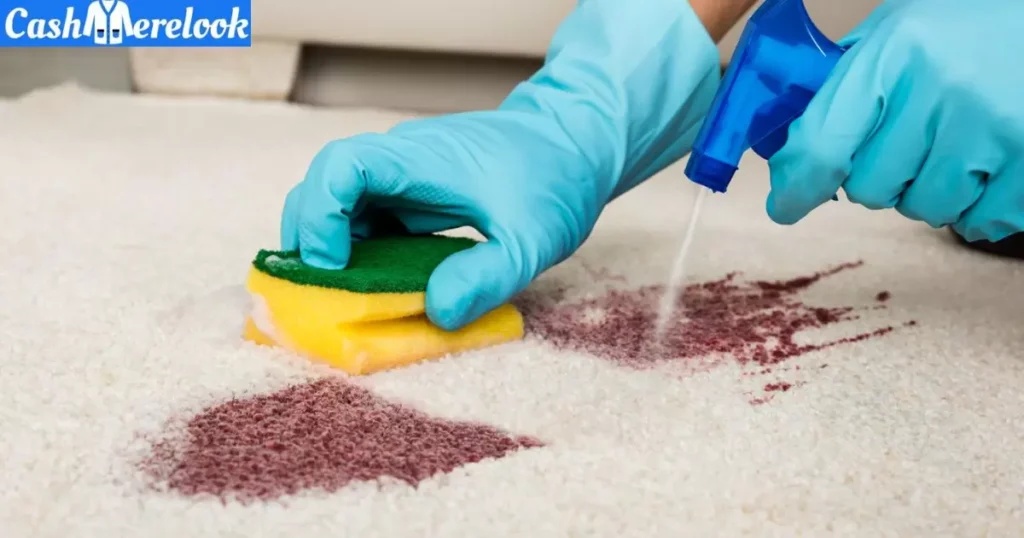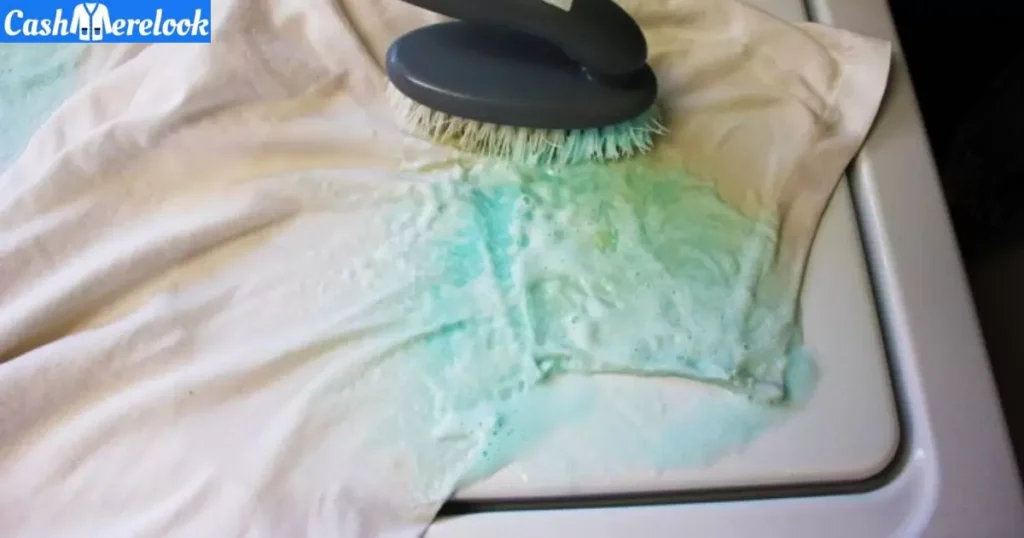Stains on cashmere can be tackled with care. Begin by gently blotting the affected area with a clean cloth. Avoid rubbing, and use a mild detergent or specialized cashmere cleaner. Rinse with cold water, pat dry and air dry flat to preserve the softness of the fabric.
Elevate your cashmere game! Gently blot away blemishes, and dodge the risky move of storing stained cashmere. It’s like playing with fire—keep them separate for a style that’s spotless and irresistibly soft!
To remove spots from cashmere, gently blot the affected area using a clean cloth. Avoid rubbing the stain as it may damage the delicate fabric. Use a mild detergent or cashmere cleaner. Rinse in cold water, pat dry, and air dry flat for softness. Storing stained cashmere is risky, like playing with fire. Keep them separate for a spotless and irresistibly soft style.
Common Types of Cashmere Clothing Stains
Choosing a stain removal method for cashmere involves considering the type of stain. Some solutions work for various substances, while others are tailored for specific stain types. Customize your approach based on the nature of the stain for effective cashmere care.
Tannin: Tannin spots, often from tea or red wine, pose a challenge. Act swiftly: blot the stain gently with a cloth. For a homemade solution, mix vinegar and water, or choose a commercial stain remover. Treat the stain promptly to prevent it from setting. Follow with proper laundering to ensure your item remains vibrant and stain-free. These steps, conquer those tannin blemishes and keep your belongings looking fresh and clean.
Protein: Protein spots, stemming from sources like meat, eggs, and bodily fluids, present a common challenge. Originating in animal-based by-products, these can be persistent. Swiftly address them by blotting with a clean cloth, applying a suitable stain remover, or using a vinegar and water mixture. From food spills to bodily fluids, effectively treat protein spots for fresh and spotless items.
Combination: Combination spots arise when various substances mix, presenting a challenge for removal. These complex marks often result from spills involving food or drinks. Swiftly address the combination by identifying the primary components and applying suitable stain removers or DIY solutions. This ensures effective removal, leaving your items fresh and clean.
Oil: Oil spots on clothes may result from natural sources like cooking oils, cosmetic sources such as makeup or lotions, and automotive oils. Whether it’s a kitchen splatter or a smudge from car maintenance, swiftly blot the stain, apply a mild detergent, and follow care instructions for spotless, fresh clothing.
Dye: Dye spots arise when colors transfer onto clothes, commonly from new items bleeding colors, spills, or mixing clothes in the laundry. Ink spots, often from pen or marker marks, can also contribute to these marks. Act promptly: blot the stain, use a suitable remover, and follow care instructions for vibrant, stain-free clothing.
Food: Food spots occur when spills or splatters from various sources land on clothes. Common culprits include spaghetti sauce, ketchup, or a drop of coffee. Be cautious with oily or colorful foods, as they can leave noticeable marks on fabrics. Swiftly addressing these by blotting with a clean cloth, using a mild detergent, and following care instructions ensures your clothes stay fresh and stain-free.
Drinks: Drink spots happen when liquids like coffee, tea, or juice accidentally spill on surfaces. These often result from pigments and compounds present in the beverages. For instance, coffee smudges are caused by tannins, while fruit juices contain natural dyes. When these substances come into contact with porous materials like fabric or carpet, they leave visible marks. Quick action is essential to prevent deep penetration. Blotting with a clean cloth and using mild cleaners can usually help remove drink marks.
Liquid: Liquid spots occur when liquids like water, juice, or beverages spill on clothes. Sources are varied—accidental spills, water splashes in the kitchen, or raindrops. Swift action is key to preventing them from setting. Blot gently, use a mild detergent and follow care instructions for liquid-free, clean clothes. Keep liquids in check and handle smudges promptly for fresh-looking attire.
Mold and Mildew: Mold and mildew spots come from the growth of fungi on clothes, usually in damp or humid conditions. Sources include wet laundry forgotten in the machine, clothes left in a humid environment, or storage in a damp place. Swift action is vital; brush off excess growth, wash with antifungal solutions, and dry thoroughly to keep your clothes mold-free.
Sweat and Makeup: When clothes get discolored or marked by different substances, it can be frustrating. Underarm sweat and makeup residue are two common types of spots that can leave their marks on clothes. Sweat spots result from perspiration, while makeup marks come from cosmetic products like foundation or lipstick. Sweat spots happen during physical activity, while makeup taints may occur during application or accidental smudges. To tackle each promptly, it’s important to pre-treat the affected area with suitable stain removers and follow the care instructions for clean, fresh clothes.
Removing Stains from Cashmere Clothes

Removing stains on cashmere offers various methods, but caution is crucial. Gentle blotting, using a mild detergent or specialized cashmere cleaner, and air-drying flat are generally safe practices. However, harsh chemicals, excessive rubbing, or hot water can damage the delicate fabric. Opt for safe methods to ensure your cashmere stays luxurious and stain-free.
Cold water on Cashmere
Cold water is key for treating cashmere stains. It helps preserve the delicate fibers and prevents damage. Hot water can harm the fabric. When dealing with spots, use cold water to gently rinse and blot. This method is particularly effective for various spots, ensuring your cashmere remains soft and free from damage.
Scoop solids off stained Cashmere
When removing solid stains from cashmere, use a blunt tool such as the edge of a spoon or butter knife to gently scoop off excess material, such as food or makeup.Be cautious to avoid damaging the fabric. Afterward, follow stain removal procedures like blotting, applying mild detergent, and rinsing with cold water to ensure a clean and stain-free result.
Safe soaps for Cashmere clothing
When washing your cashmere clothing, opt for soaps that are gentle and pH-neutral. Specifically, choose detergents labeled for wool or cashmere. These mild options help preserve the delicate fibers, ensuring your cashmere remains soft and in top condition after each wash. Avoid harsh chemicals, and follow care instructions for a longer-lasting, clean wardrobe.
Vinegar rinses for Cashmere sweaters
Revitalize your cashmere sweaters with vinegar rinses. Mix a solution of one part white vinegar to two parts cold water. Gently submerge the sweater, allowing it to soak for 15 minutes. This natural method helps remove odors and restores softness. Afterward, rinse with cold water and pat dry with a towel. Avoid wringing or twisting. Vinegar acts as a gentle conditioner, maintaining the integrity of the fibers. Follow care instructions for best results, enjoying refreshed and odor-free cashmere that retains its luxurious feel.
Washing Cashmere After Stain Removal
After successfully removing stains on cashmere, follow these simple steps to wash and maintain its pristine condition. Fill a basin or sink with cold water and add a small amount of mild detergent specifically designed for wool or cashmere. Gently agitate the water to create suds.
Submerge the cashmere item, allowing it to soak for a short period, typically 10-15 minutes. Gently rub any remaining stained areas with your fingers, avoiding harsh scrubbing. Drain the soapy water and refill the basin with clean, cold water for rinsing. Gently agitate again to remove detergent residue.
Carefully lift the cashmere item, supporting its weight to prevent stretching, and press out excess water without wringing or twisting. Lay the item flat on a clean, dry towel, reshape it to its original dimensions, and roll the towel to absorb additional moisture. Finally, lay the cashmere item flat on a dry towel or a mesh drying rack, shaping it to its intended form. Allow it to air dry completely.
By following these steps, you ensure that your cashmere remains soft, stain-free, and retains its luxurious quality. Remember to always adhere to the care instructions provided with your cashmere items for the best results.
How to remove old stains from cashmere?
To safeguard the color of cashmere while removing old stains, start by gently blotting the affected area with a clean cloth. Add a solution of mild detergent and cold water to the stain with a soft cloth or sponge. Let the solution sit for 15-20 minutes, then rinse thoroughly with cold water and blot dry. This method effectively tackles spots on cashmere without compromising the delicate fabric’s color integrity.
Using a mild detergent and cold water is critical to prevent color alteration in cashmere. This approach prioritizes gentle care, ensuring the garment remains in optimal condition. If the stain persists, professional dry cleaning is an option, but always consult the care label for specific guidelines to maintain the quality and longevity of your cashmere item.
How to remove sweat stains from cashmere?

To get rid of sweat stains on cashmere, start by gently blotting the stained area with a clean cloth. Avoid rubbing, as it can damage the delicate fibers. Mix a solution of cold water and a small amount of mild detergent. Apply the solution to the stain using a soft cloth or sponge, patting gently. Allow it to sit for 15-20 minutes to break down the sweat residue.
Rinse the area thoroughly with cold water, ensuring all detergent is removed. Blot the spot dry with a clean cloth. Always follow the care label instructions on your cashmere garment. If the stain persists, consider professional dry cleaning. It’s essential to address sweat stains promptly to prevent them from setting into the fibers. With gentle care and quick action, you can effectively remove sweat spots from cashmere, preserving its quality and color.
Will baking soda ruin cashmere?
Using baking soda on cashmere can be risky. Baking soda is abrasive and may harm the delicate fibers of cashmere, causing damage and altering its texture. It can lead to pilling or fuzziness, ruining the softness of the fabric. It’s safer to stick to mild detergents and gentle cleaning methods specifically recommended for cashmere care. Always check the care label on your cashmere item for instructions to preserve its quality and avoid unintended damage.
Can you use vinegar on cashmere?
Using vinegar on cashmere is not advisable, as it can harm the delicate fibers of this luxurious fabric. Vinegar is acidic, and its application may lead to a loss of softness and shine in cashmere. Additionally, there’s a risk of color alteration and potential damage to the fabric’s integrity. The acidity in vinegar can weaken the fibers, making them susceptible to issues like pilling and fuzziness, compromising the overall quality of the garment.
For safe and effective care, it’s best to steer clear of vinegar and opt for cleaning methods specifically designed for cashmere. Stick to mild detergents and always consult the care label instructions provided by the manufacturer. This ensures the proper maintenance of your cashmere items, preserving their softness, vibrancy, and longevity.
How do you fix ruined cashmere?
Fixing ruined cashmere can be challenging, but with some care, you can attempt to restore it. If the damage is minimal, like pilling or fuzziness, use a cashmere comb or a fabric shaver to gently remove the excess fibers. For larger issues like holes or tears, consider professional repair services or seek assistance from a skilled tailor
If you need to deal with stains on your cashmere clothing, here are some tips that might help., act promptly. Blot the stain with a clean cloth and use a mixture of cold water and mild detergent. Avoid harsh chemicals, as they can worsen the damage. Always follow the care label instructions provided by the manufacturer for the best results.
Prevention is key to maintaining cashmere. Store it folded, not hung, and keep it away from direct sunlight. Hand wash in cold water or opt for professional dry cleaning. By handling cashmere with care and promptly addressing issues, you can extend its life and enjoy its luxurious feel for a longer time.
Does Cashmere get ruined by water?
Cashmere can handle water, but it requires careful treatment. Excessive water exposure or soaking can lead to stretching and loss of shape. It’s crucial to avoid wringing or twisting the wet fabric, as this can damage the delicate fibers. Instead, gently press out excess water and reshape the garment. Use a mild detergent for handwashing in cold water and avoid hot temperatures, as they can cause shrinkage.
While cashmere can tolerate water when handled properly, it’s essential to follow care label instructions and not subject it to harsh conditions. Air-dry flat to prevent distortion and avoid direct sunlight, which may affect the color. Overall, cautious water care, proper drying, and adherence to care guidelines will help maintain cashmere’s softness and quality.
Any tips for how to remove these stains from cashmere?
Aspirin Solution: Crush an aspirin and mix it with cold water to form a paste. Apply it to the stain, let it sit for a bit, then rinse gently.
Vinegar and Lemon Juice: Mix equal parts vinegar and lemon juice. Dab the stain with this solution, let it sit briefly, then rinse with cold water.
Cornstarch Absorption: For oil-based stains, sprinkle cornstarch on the spot. Let it absorb the oil for a few hours, then brush it off and proceed with regular cleaning.
FAQ’s
How to get stains out of cashmere?
Blot stains on cashmere with a gentle touch, using a mix of mild detergent and cold water for effective stain removal.
How to wash cashmere?
Handwash cashmere in cold water with mild detergent, then gently air-dry.
conclusion
To effectively remove stains from cashmere, begin by blotting with a clean cloth, avoiding aggressive rubbing. For water-based spots, lightly dampen and blot with cool water; for oil-based marks, use a mild detergent. Never wring or twist cashmere; gently press out excess water and lay flat to air dry, reshaping when necessary.
Consider professional dry cleaning for stubborn stains, checking the care label first. Preventive measures include storing in a cool, dry place and avoiding wearing during meals to ensure the longevity of your luxurious cashmere pieces.












